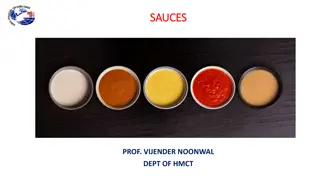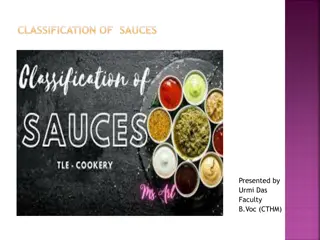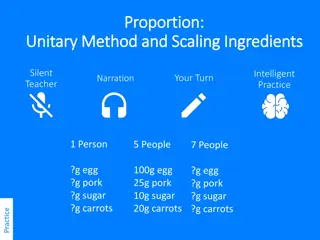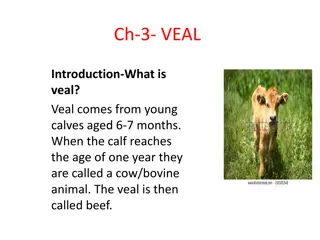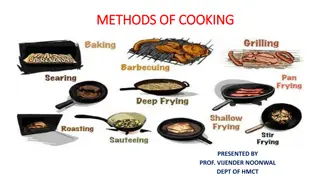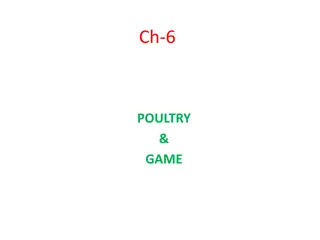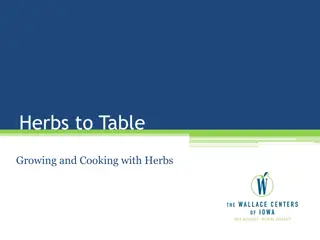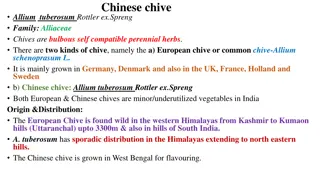A Comprehensive Guide to Sauces in Cooking
Explore the world of sauces in cooking, from classic options like Beurre Blanc and Pesto Sauce to industry staples like Soya Sauce and Worcestershire Sauce. Learn about different sauce types, their origins, and how they are used in various cuisines such as Asian and Western culinary traditions.
Download Presentation

Please find below an Image/Link to download the presentation.
The content on the website is provided AS IS for your information and personal use only. It may not be sold, licensed, or shared on other websites without obtaining consent from the author. Download presentation by click this link. If you encounter any issues during the download, it is possible that the publisher has removed the file from their server.
E N D
Presentation Transcript
SAUCES SAUCES PROF. VIJENDER NOONWAL DEPT OF HMCT
CONTEMPORARY SAUCE CONTEMPORARY SAUCE These sauces are simple, less rich and easy to prepare. These are more likely to tailored to be techniques. Some of them are: Beurre Blanc (Hot emulsified butter sauce) Pesto Sauce (Italian basil based sauce) Compound Butter (Mixture of butter and supplementary ingredients) be given specifically food or
PROPIETARY SAUCE PROPIETARY SAUCE They are industry based sauces. List of six common proprietary sauces used in cooking:- 1. Soya Sauce 2. Worcestershire Sauce 3. Barbecue Sauce 4. Ketchup 5. Tabasco Sauce 6. Chili Sauce.
SOYA SAUCE SOYA SAUCE The sauce is made from soya beans, wheat, water, and salt. Other ingredients can also be used, the most common one being anchovies fish paste. Dark soya sauce is usually used for cooking and a light soy sauce for seasoning.
SOYA SAUCE SOYA SAUCE It is a basic condiment from South-East Asia and Japan (it is called shoyu in Japan and jiang yong in China). Soya sauce was first used to preserve food for the winter months, though it is now used as a common flavouring agent in kitchens from east to west.
SOYA SAUCE SOYA SAUCE Soya sauce has the same nutritional value as meat extract and improves with age. In Japanese cooking it is used mainly to season grilled kebabs, tofu, cold vegetable, fish salads, fritters, and sashimi. In China soya sauce is mainly used in marinades and stewed dishes, while in Indonesia it is mainly a table condiment.
WORCESTERSHIRE SAUCE There is a story that two pharmacists by the name of Lea and Perrins formulated this sauce at an order given by one retired army officer, who had savoured this recipe in India. Not impressed with the result, he returned the sauce and it was stored away in a store and was forgotten about.
WORCESTERSHIRE SAUCE It is soya and vinegar based but also contains an assortment of exotic ingredients, the proportions and precise details of which remains the manufacturer s secret. After the invention of Worcestershire sauce, many other sauces were derived from it by adding few ingredients. The very famous A-1 steak sauce is a beef steak sauce made by combining LP sauce with vinegar, soya, tamarind, sugar, and a variety of spices.
HP SAUCE HP SAUCE Also called Brown sauces, are excellent accompaniments to red meats, providing a sharp contrasting taste. Lighter versions of some brown sauces, made with white wine are available for poultry, light meats, fish, and white sauces.
BARBECUE SAUCE Commercial barbecue sauces originated in the USA. Commercial ones are quite similar to homemade ones, but they usually have a higher concentration of salt, sugar, and vinegar to help them to preserve. May be used in marination, or simply brushed onto the meat while it is cooking. This sauce can also be used as a dipping sauce.
KETCHUP The name is derived from Malaysian ketjap, brine in which fish is usually pickled. In South-East Asia, ketchups made from fish and shellfish are still very common; but in the Western world, a ketchup or catsup is a tomato sauce which has been generic name for any tomato sauce made with vinegar. All ketchups include salt and spices, and often vinegar and sugar.
TABASCO SAUCE The chilli or hot red pepper is the principal ingredient of commercially prepared hot sauces and relishes. This is an American chilli sauce made in Louisiana, but named after a state in Mexico which boasts about the spiciest chillies in the world. History states that it was made by an American citizen in 1868, when one of his friends brought him chillies from Mexico while he was away on campaigns. Mexican-American
TABASCO SAUCE For Tabasco, fresh ground chillies are salted and left to mature for up to three years. The liquid is then extracted, mixed with distilled vinegar, and bottled.
CHILLI SAUCE It is usually a fairly thick hot sauce as distinct from the thin Tabasco sauce. Chilli sauce is prepared from pulped peppers, flavoured with garlic and vinegar, and thickened with cornstarch. Chilli sauce is usually condiment with Chinese dishes. This sauce is not be confused with homemade chilly paste. eaten as a
DIFFERENCE BETWEEN SAUCES DIFFERENCE BETWEEN SAUCES MOTHER SAUCE CONTEMPORARY SAUCE PROPIETORY SAUCE Sauces often thicken them used flour to Sauces use reductions of the liquid itself rather than adding a starch, or don't thicken it at all. Industry made Recipe is unknown Sauces are generally created by taking a "mother" sauce (e.g. veloute, bechemal, and adding ingredients to create desired variation. Sauces structured typography. don't have such a supreme) flavouring Classical separate from dish sauces prepared Contemporary prepared as part of the dish


